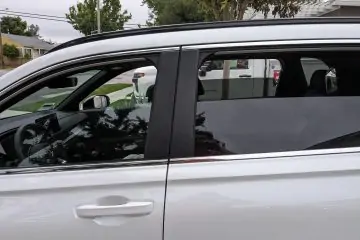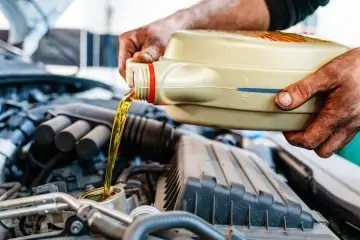The “Stop/Start Not Ready Battery Charging” message usually indicates an issue with the vehicle’s auxiliary battery. This problem is often due to an internally shorted auxiliary battery.
A “Stop/Start Not Ready Battery Charging” alert can be a common issue in modern vehicles equipped with start/stop technology. Start/stop systems aim to enhance fuel efficiency by automatically shutting down and restarting the engine at brief stops. The auxiliary battery plays a crucial role in this process by maintaining power to the vehicle’s systems when the engine is off.
If the auxiliary battery is malfunctioning or has an internal short, the system will display this message. Ensuring your battery’s health and using a compatible smart charger can help mitigate this issue and keep your vehicle running smoothly.
Credit: www.jlwranglerforums.com
Understanding Start-stop Technology
Start-Stop Technology is a feature in modern vehicles designed to improve fuel efficiency and reduce emissions. This system automatically shuts down and restarts the engine when the vehicle is stationary, such as at traffic lights or in heavy traffic. It helps to save fuel and reduce the environmental impact of driving.
How It Works
Start-Stop Technology relies on sensors and the vehicle’s computer to determine when the engine should shut off and restart. When the car comes to a stop, the system cuts the engine. When the driver releases the brake or engages the clutch, the engine restarts automatically.
- Engine shuts off when the car stops.
- Engine restarts when the brake is released.
- Uses sensors to monitor vehicle status.
Benefits
Start-Stop Technology offers several benefits that make it a valuable feature in modern vehicles.
| Benefit | Description |
|---|---|
| Fuel Efficiency | Reduces fuel consumption by shutting off the engine at stops. |
| Lower Emissions | Decreases emissions by reducing idle time. |
| Engine Longevity | Reduces engine wear by limiting idle time. |
| Cost Savings | Saves money on fuel and maintenance. |
Common Causes Of ‘not Ready’ Message
The ‘Not Ready’ message in stop-start systems can be frustrating. Understanding the common causes can help you diagnose and fix the issue. This section explores the typical reasons behind this message.
Auxiliary Battery Issues
The auxiliary battery supports the main battery in stop-start systems. If you see a ‘Not Ready’ message, the auxiliary battery may be failing.
Here are some common causes related to the auxiliary battery:
- Low Charge: The auxiliary battery might not hold a charge properly.
- Internal Short: An internal short can cause the battery to malfunction.
- Battery Age: Over time, batteries degrade and lose efficiency.
A quick check with a multimeter can reveal if the auxiliary battery is the issue. Keeping the auxiliary battery in good condition is essential for the stop-start system to function correctly.
Main Battery Problems
The main battery plays a crucial role in the stop-start system. Problems with the main battery can also trigger a ‘Not Ready’ message.
Consider these common causes related to the main battery:
- Insufficient Charge: The main battery may not be fully charged.
- Battery Health: A degraded battery might struggle to maintain the required charge.
- Connection Issues: Loose or corroded terminals can affect battery performance.
Conducting a battery health check can help identify the root cause. Ensuring that the main battery is in optimal condition is vital for the reliability of the stop-start system.
Here is a simple table to summarize the common causes:
| Battery Type | Common Causes |
|---|---|
| Auxiliary Battery |
|
| Main Battery |
|
Diagnosing Battery Problems
Understanding how to diagnose battery problems is crucial. Especially in vehicles with stop-start systems. A healthy battery ensures reliable performance. This guide will help you check battery health and identify shorted batteries.
Checking Battery Health
Regularly checking your battery’s health is essential. It helps maintain the efficiency of your stop-start system. Here’s a simple guide:
- Visual Inspection: Look for corrosion on terminals.
- Voltage Test: Use a multimeter to check the voltage.
- Load Test: Test the battery under load conditions.
Pro Tip: Keep your battery clean and well-maintained. This prevents unexpected failures.
Identifying Shorted Batteries
A shorted battery can cause the stop-start system to malfunction. Identifying a shorted battery is vital for vehicle performance. Follow these steps:
- Check Voltage: A significantly low voltage indicates a short.
- Inspect for Swelling: Physical swelling can be a sign of a short.
- Use a Battery Tester: Specialized testers can identify internal shorts.
Remember: Shorted batteries need immediate replacement. This ensures the longevity of your vehicle’s electrical system.
| Check | What to Look For | Action |
|---|---|---|
| Visual Inspection | Corrosion, Dirt | Clean Terminals |
| Voltage Test | Low Voltage | Charge or Replace |
| Load Test | Voltage Drop | Replace Battery |
| Short Check | Swelling, Low Voltage | Replace Battery |
Charging Start-stop Batteries
Charging start-stop batteries is crucial for maintaining the efficiency of vehicles equipped with start-stop technology. These batteries differ from conventional ones and require specific care and equipment. Let’s explore the essentials of charging these batteries.
Charging Time
The charging time for start-stop batteries varies based on several factors, including the battery type and its current charge level. On average, it takes about 4 to 6 hours to fully charge an AGM (Absorbent Glass Mat) battery. EFB (Enhanced Flooded Battery) types may take slightly longer.
To optimize charging time, ensure the battery is not deeply discharged. Regular charging can help maintain the battery’s health and reduce overall charging duration.
Suitable Chargers
Suitable chargers for start-stop batteries are crucial for ensuring proper charging and longevity. Not all chargers are compatible with these advanced batteries. Here are some recommended types:
- Smart Chargers: These are specifically designed for AGM and EFB batteries. They automatically adjust the charging rate based on the battery’s condition.
- Pulse Chargers: These chargers use high-frequency pulses to reduce battery sulfation, enhancing battery life.
- Multi-Stage Chargers: These provide a more controlled and gradual charging process, beneficial for start-stop batteries.
| Charger Type | Features |
|---|---|
| Smart Chargers | Automatic adjustment, safe for AGM/EFB |
| Pulse Chargers | Reduces sulfation, extends battery life |
| Multi-Stage Chargers | Controlled charging, ideal for start-stop |
Using the correct charger not only improves the charging efficiency but also maximizes the lifespan of start-stop batteries. Always refer to the battery manufacturer’s guidelines for the best results.
Impacts Of A Dead Start-stop Battery
A dead start-stop battery can bring your vehicle to a halt. This advanced system is essential for fuel efficiency and reducing emissions. Understanding its impacts helps maintain your car’s functionality.
Accessory Functionality
With a dead battery, accessory functions suffer. These include:
- HVAC system
- Radio
- Heated seats
These functions rely on the battery when the engine stops. A depleted battery means no comfort features during stops.
Restart Mechanism
The restart mechanism is crucial for start-stop systems. It ensures the engine restarts smoothly after stopping. A dead battery disrupts this process.
Here’s what happens when the battery fails:
| Stage | Impact |
|---|---|
| Engine Stop | Battery powers accessories |
| Battery Depletion | Accessories shut down |
| Engine Restart | Fails without battery power |
The vehicle needs a charged battery for smooth restarts. Without it, you might face engine stalls and delays.

Credit: www.youtube.com
Maximizing Battery Lifespan
Ensuring the longevity of your vehicle’s battery is essential. This is especially true for cars with start-stop systems. These systems put extra strain on the battery. Proper care can extend its life. Below, we explore ways to keep your battery in optimal condition.
Maintenance Tips
Regular maintenance is crucial for maximizing battery lifespan. Here are some effective tips:
- Check battery terminals: Ensure they are clean and free from corrosion.
- Inspect water levels: If your battery is not sealed, maintain proper water levels.
- Test the battery: Regularly test the battery’s charge status using a voltmeter.
Avoiding Common Pitfalls
There are common mistakes that can shorten your battery’s lifespan. Avoid these pitfalls to ensure longevity:
- Overcharging: Overcharging can damage the battery. Use a smart charger to prevent this.
- Undercharging: Frequently short trips can lead to undercharging. Take longer drives occasionally.
- Ignore warning signs: Pay attention to warning messages like “start-stop not ready.”
User Experiences And Solutions
Many car owners encounter the “Stop-Start Not Ready Battery Charging” message. This issue affects the functionality of the start-stop system. Below, explore user experiences and solutions sourced from various forums and expert recommendations.
Forum Insights
Car forums provide a wealth of information from real users. Here are some common insights:
- Common Causes: Users frequently cite shorted auxiliary batteries as a cause.
- Temporary Fixes: Some have found temporary relief by resetting the car’s battery.
- Warning vs. Advisory: Many users note that the message is often an advisory, not a warning. This is important to understand.
Here’s a table summarizing forum insights:
| Insight | Description |
|---|---|
| Common Causes | Shorted auxiliary batteries |
| Temporary Fixes | Resetting the car’s battery |
| Warning vs. Advisory | Message is often advisory |
Expert Recommendations
Experts offer actionable solutions to address this issue. Here are some top recommendations:
- Check the auxiliary battery. Replace if needed.
- Use a smart charger for AGM or EFB batteries.
- Regularly monitor battery health to avoid future issues.
Following these expert tips can prolong your battery life and keep the start-stop system functional.

Credit: www.reddit.com
Frequently Asked Questions
What Does It Mean When It Says Start-stop Not Ready?
The “start-stop not ready” message indicates that the vehicle’s battery is charging or not sufficiently charged.
How Long Does A Stop-start Battery Take To Charge?
A stop-start battery typically takes 2-4 hours to charge using a smart charger.
Do You Need A Special Battery Charger For Stop-start Battery?
Yes, you need a special charger. Use a smart charger designed for AGM or EFB batteries.
What Happens When An Auto Start-stop Battery Dies?
The car won’t start automatically. Manual start may be required. Accessories like radio may stop working. Battery replacement is necessary.
Conclusion
Ensuring your vehicle’s stop-start system functions properly is crucial. Regular maintenance and timely battery replacement can prevent issues. Check your battery’s health frequently, and use the correct charger. Staying proactive helps maintain your vehicle’s performance and efficiency. Your car will thank you with a smoother ride and fewer disruptions.

